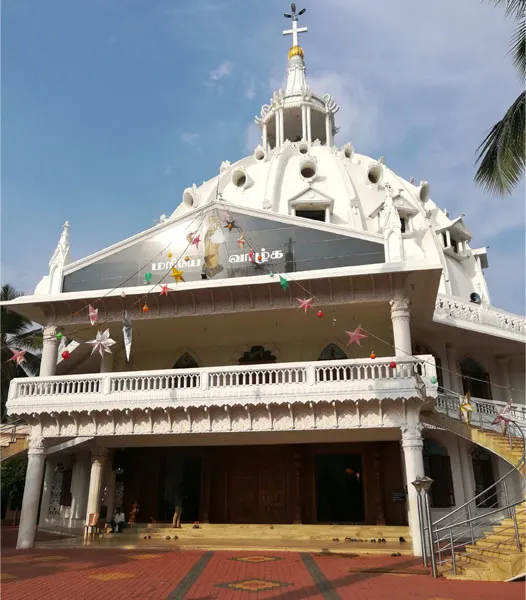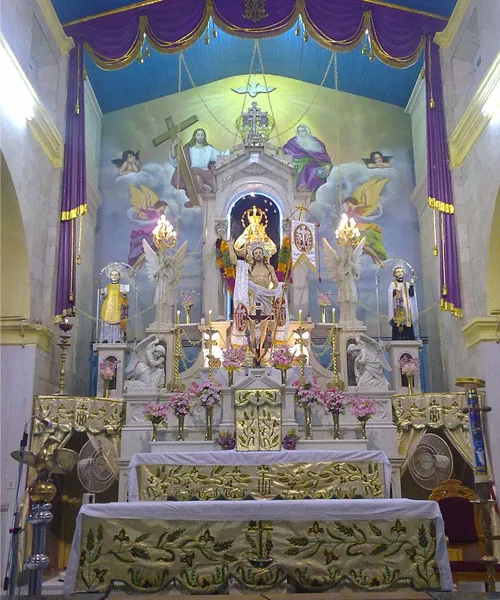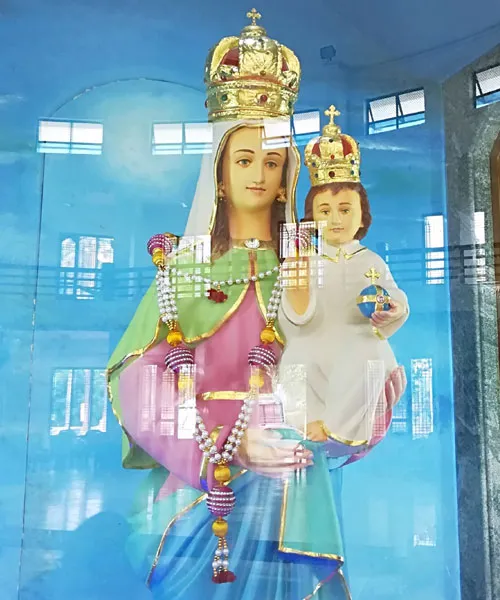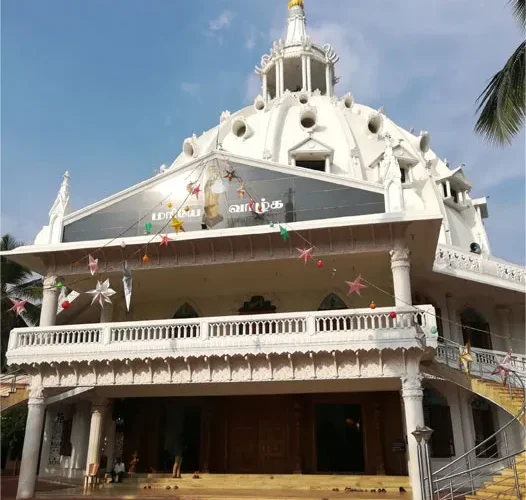
Introduction
Mary Matha Shrine is a Roman Catholic church located at Thiruvithamcode in Kanyakumari District of Tamil Nadu in India. The church is alternatively known as the Church of the Ascension of our Lord or the Ascension Jesus Church, thought to have been founded by St. Francis Xavier. The shrine of Mary at Thiruvithamcode holds significant historical importance. Moreover, the visits of numerous saints to this site have sanctified the soil, further enhancing its significance. Thiruvithamcode was formerly a part of the Kingdom of
Description
According to historical records, the old church was constructed by the Venadu King over a thousand years ago. Within its premises lies the tomb of Fr. Adhirian, and it houses the traditional Annai statue, where Our Lady stands on a lotus. Every Wednesday at 5:00 pm, Rosary and Novena services are conducted, followed by the celebration of the Holy Eucharist in this historic church. In 2012, a new church was built and blessed alongside the old one. This new structure incorporates various cultural arts, including Dravidian, Travancore, Islamic, and Gothic styles. The design of the new church draws inspiration from St. Peter’s Basilica in Rome. The mysteries of the Holy Rosary are engraved on the front doors, aiding worshippers in their prayers. The pillars at the main entrance bear resemblance to the opulence of the Padmanabhapuram Palace.

Ancient Times
During the rule of the Chera dynasty, the country was divided among 156 petty kings, each governing their own territory known as a ‘code.’ One such code was Thiruvithamcode. On January 29th, 311 AD, Kulasekhara Perumal became the first king of Thiruvithamcode, marking a significant event in its history. Thiruvithamcode held prominence even during the time of the Chera kings. Records such as the English title ‘Travancore State Gazette,’ referred to in government documents as Thiruvithamcode Sarkar Gazette in Malayalam, attest to its importance, even into the early 19th century.
However, a deeper examination of its history takes us back to the first century AD. Legend holds that St. Thomas, one of Jesus’ twelve disciples, arrived in Thiruvithamcode during this period and preached the gospel. He purportedly built a church dedicated to Our Lady in 70 AD, known today as the “Thiruvithamcode Arappally,” currently owned and maintained by the Syrian Orthodox Christian community. Followers of St. Thomas continued spreading Christianity in the region, utilizing St. Mary’s Arappally as their place of worship. Despite being closed for many centuries, this historical church stands as evidence of Christianity’s presence in Thiruvithamcode since the first century.
11th Century
A historical document dating back to 1060 reveals that the interior fishermen community from Palayam to Thittuvilai regarded Thiruvithamcode as a significant place. The presence of a Church and presbytery atop it, catering to Christians from Trivandrum to Vadakkankulam, underscores the importance of this location to Christians as well. In 1544, when St. Francis Xavier visited King Rama Varma and his brother Marthanda Varma, who were residing in the Thiruvithamcode palace, to deliver a message from the Portuguese governor regarding military assistance, he also visited this Church.
St. Francis Xavier received permission to preach in the coastal villages of Tamil Nadu from Thiruvithamcode. He stayed here for a period, marking the beginning of his missionary work in Tamil Nadu. In 1682, St. John de Britto, who centered his missionary efforts in Madurai, visited this church while at the Jesuits’ house in Pillai Thoppu. During the persecution of Devasahayam Pillai for his acceptance of the Gospel, he was publicly humiliated by being paraded on a buffalo through the streets of Thiruvithamcode.
A tunnel located on the northern side of the church is believed to have been used to imprison Devasahayam Pillai, who was later transferred to Keralapuram, situated nearby. For many centuries, this parish operated independently. Missionaries from various congregations, including Jesuits, Franciscans, and Carmelites, have served here. Historical records from 1765 indicate that villages such as Aatoor, Eraniel, Mulagumoodu, Manalikarai, Pazhayakadai, Puthenkadai, Vaaruthattu, Mekamandapam, Padmanabhapuram, Thalakuzham, and Thikkanamkodu, inhabited by the Chavalkarar or Mukkuva communities, were affiliated with Thiruvithamcode both professionally and culturally.
18th Century
In 1708, Fr. Simon De Carvalheev and later Fr. Meynord, both Carmelites, served as Parish Priests of Thiruvithamcode. By 1717, Rev. Fr. Louis Rodrigues held the position of Shrine Rector in Thiruvithamcode. Rev. Fr. Athiriyan, born in Spain in 1818 and ordained in 1848, served as Rector of this Shrine. In 1860, while ministering at Thikkanamkodu Church, he passed away and was interred at Thiruvithamcode Shrine, as indicated by an inscription tablet in the church. There persists a belief that rolling children on Fr. Athiriyan’s tomb would bring them good health.
Following Fr. Athiriyan’s demise, Thiruvithamcode and its affiliated villages became sub-stations of Karamkadu Parish. Subsequently, it was under Mulagumoodu in 1861, Kalkurichy in 1954, and Mailacodu in 1971. On October 15, 2004, Most Rev. Bp. Leon A. Dharmaraj, then Bishop of Kottar, declared Thiruvithamcode an independent parish, marking its reestablishment after 156 years. Thiruvithamcode parish is now part of the newly formed Kuzhithurai Diocese, recognized as one of the emerging shrines in the district.
Initially dedicated to Our Lady of Assumption, the church in Thiruvithamcode was later patronized by the Ascending Lord, though historically it was called the Church of Annai, following Veeramamunivar’s influence. Devotion to Mary began after a miraculous event where a fisherman, caught in a storm at sea, prayed to Annai for intercession, vowing to start a devotion to Mary if saved. With Annai’s help, he reached shore safely and initiated the devotion, formally started 18 years later during Rev. Fr. Pascal Raj’s tenure. Since then, numerous devotees and pilgrims have flocked to the shrine, witnessing miracles attributed to Annai’s intercession.
The Church, patronized by the Ascending Lord, celebrates its feast for 10 days during the Easter season, commemorating the Ascension of our Lord. Additionally, a three-day Feast for Matha is held at the end of January. Mass and Novena are conducted every Friday at 11:30 AM and 5:00 PM, respectively. Devotees from Thirunelveli, Thoothukudi districts, and Kerala state frequently visit this Shrine. Through the grace of Our Lord and the intercession of Mary Matha, this shrine has become a place where people from diverse backgrounds come together, transcending caste, state, and religion, to experience God’s grace.

Annual Feast Day
Feast Date : End of January
The annual feast day of the Periyanayaki Shrine in Thiruvithancode is celebrated with a three-day Feast for Matha held at the end of January each year.
Mass Timing
Every Friday : 11:30 AM and 5:00 PM
Church Visiting Time
Monday to Saturday : 08:00 am to 06:00 pm
Contact Info
68P2+JQH,
Thiruvithankodu,
629174T,
Tamil Nadu,
India.
Accomodations
Connectivity
Airway
The nearest major airport is the Periyanayaki Shrine in Thiruvithancode is Tuticorin Domestic Airport. Which is 130 km from the Shrine.
Railway
The nearest railway station to the Periyanayaki Shrine in Thiruvithancode is Kanniyakumari Railway Station. Which is 35.6 km away from the Shirne.








